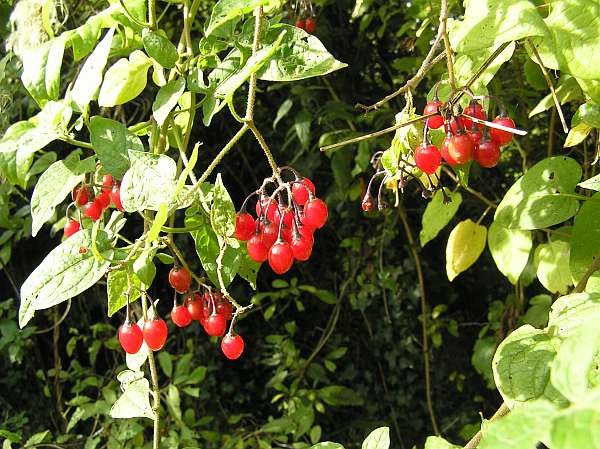Dioscoria communis - Black Bryony
Phylum: Magnoliophyta - Class: Equisetopsida - Order: Dioscoriales - Family: Dioscoriaceae

Above: Black Bryony berries in October
Black Bryony, a perennial climbing plant, is a member of the yam family.
Description
Black Bryony climbs over fences, bushes and hedgerows assisted by its tendrils, which always spiral anticlockwise. The tiny flowers are 4 to 6mm across and have six pointed petals. Male and female flowers occur on separate plants. The female flowers produce bright red 'berries' in autumn, and they persist well into winter.

Typically 7 to 10 cm long and 5 to 8 cm across, the leaves of Black Bryony are heart-shaped and their upper sides are shiny.
Distribution
Found throughout Britain and Ireland, but rare in Scotland and most of Wales, White Bryony is most plemtiful in central and southern England. Elsewhere, Bryonia dioica is quite common in many parts of central and southern mainland Europe, and its native range extends into parts of Asia.
Habitat
This scrambling plant of hedgerows and woodlands crawls up all sorts of plants including nettles, brambles, low-growing bushes and young trees (as well as wire fences!). Black Bryony often attain a height of 1 to 3 m and occasionally more.
Blooming times
The creamy-green flowers of Black Bryony can be seen between May and August.
Etymology
The specific epithet communis means 'growing communally (in grouos)' - a reference to the clusters of flowers and, later, berries...
Uses
Many people like to collecg Black Bryony berries for table decorations in late autumn and early winter, as they tend to persist for many weeks. As with White Bryony, they are, however, poisonous and so should be kept well away from young children.
Please Help Us: If you have found this information interesting and useful, please consider helping to keep First Nature online by making a small donation towards the web hosting and internet costs.
Any donations over and above the essential running costs will help support the conservation work of Plantlife, the Rivers Trust and charitable botanic gardens - as do author royalties and publisher proceeds from books by Pat and Sue.



